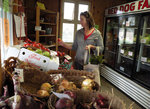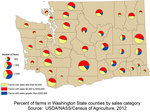Jefferson County shows up as a blip on a Washington state map of the economics of agriculture – only 200 or so farms that earn less than $10 million compared to the more than $10 billion value of …
This item is available in full to subscribers.
We have recently launched a new and improved website. To continue reading, you will need to either log into your subscriber account, or purchase a new subscription.
If you had an active account on our previous website, then you have an account here. Simply reset your password to regain access to your account.
If you did not have an account on our previous website, but are a current print subscriber, click here to set up your website account.
Otherwise, click here to view your options for subscribing.
* Having trouble? Call our circulation department at 360-385-2900, or email our support.
Please log in to continue |
|




Jefferson County shows up as a blip on a Washington state map of the economics of agriculture – only 200 or so farms that earn less than $10 million compared to the more than $10 billion value of crops and livestock from more than 37,000 farms statewide.
The reality is that Jefferson County is mostly forestland, not farmland, and some of the soil is peat, or packed so hard by glaciers that it's difficult for some crops to take root.
Then there's the out-in-the field and at-the-farmers-market reality, the one that Laura Lewis, director of the Washington State University (WSU), Jefferson County Extension, sees, smells and tastes.
That's the reality that anyone who checks out the free, self-guided 13th annual Jefferson County Farm Tour this weekend should see.
That reality is award-winning farmstands packed with fresh organic produce and enthusiastic and creative farmers, some of whom are known nationwide.
And at the heart of it all is a community that cares about what it eats, say Lewis and others who have been watching the state of Jefferson County's farming for a decade.
“What is unique about Jefferson County is that we have a really robust agricultural section yet we don't have the best soils in the state. This isn't the first place you'd want to farm. What we do have is a population that wants to support agriculture and especially organic agriculture,” Lewis said.
The Jefferson County Farmers Market is also proof of the robust state of farming in Jefferson County.
Both Lewis and Will O'Donnell – director and market manager of the Jefferson County Farmers Market – as well as farmers say consumer appetite for fresh and local vegetables and meats has helped those farms grow over the last decade.
“When I started in 2000, the total farmers market gross was $100,000 [a year] and there were five or six farmers. The farmers market has been a center for farming growth from 2000 to 2010. We were where all those businesses got started,” said O'Donnell, noting that today, there are six times as many vendors as there were a decade ago, and the market boasts almost $1 million a year in sales.
Locals are so dedicated, O'Donnell said, that during a recent summer windstorm where some vendors didn't turn out, most of those farmers who did show up made the same amount of money as they normally do.
“We're the Vermont of Washington, this neat little isolated place with lots of educated, independent-minded people. We're a speciality county producing specialty crops,” said O'Donnell. “Our farmstands are uniformly gorgeous and I think that's because we have such a high-quality customer base and our farmers want to please them.”
O'Donnell, who has been in on at least three different farm ventures and is exiting his farmers market job for his next challenge, said there is something about adversity that makes people become creative.
“It's a blessing in a way. We have to embrace our limitation and be creative. And we'll be successful as long as we do that,” he said.
GOOD RELATIONSHIPS
Zach Wailand and Haley Olson of Dharma Ridge Farm know about adversity and perseverance.
The two met each other while working on a farm owned by John Gunning in the 1990s, when Gunning owned three farms.
Together, the couple have started three farms and have grown not only a family but their farming business over the last 10 years. They outgrew a 5-acre farm in Chimacum, started leasing 10 acres in Beaver Valley, then moved to Quilcene, where they now lease from John Boulton, who had cattle and hay on the farm for decades.
They know all about the peat soils and shorter seasons because of flooding.
“We made do with what we had,” said Olson. “There's not a lot of land available and a lot that was available [in 2000] was not affordable. It wasn't like you could go talk to a real estate agent and say, 'I'd like to buy 75 acres of land in this area.' It doesn't exist,” she said.
The couple credit their success to the growth of the farmers markets and to the Port Townsend Food Co-op. They sold the 10 acres and have been hoping to buy the Boulton farm, which has 140 acres available, between 25 and 30 acres of which Wailand and Olson are farming.
“We're in a holding patten,” said Olson.
Wailand said he understands why Boulton, 89, is reticent to sell. “I can picture myself in his shoes,” said Wailand of working the land for so long, having so much invested in it.
Wailand said he doesn't want to leave Jefferson County because of the relationships he's built up over the years – at the market, at the co-op and with customers.
“The reason why we stayed here is because Haley's family is here and I've lived here a long time and we have lots of good connections and community support here for our business. It's taken years to establish a relationship. To start that over in a new location is not so appealing,” said Wailand.
Olson echoes that. “The PT co-op is a huge supporter. They help us pay our bills through the food they buy. We've talked to other farmers and their experience with co-ops is not the same,” she said of other farmers in other communities. “They're just a huge support. It's a big account for us.”
Olson believes there is a transition movement from the dairy industry – there's only one farmer left in Jefferson County that has a dairy and that's Gerald Bishop – to row-crop farming. And with that transition comes those challenges that O'Donnell is talking about.
“Historically, this area has been more hay farming and dairying, so for vegetable farming, the resources are limited. The tractor breaks, there's one guy who can fix it. We're not in an area where there are a lot of resources,” she said.
What that means is that vegetable farmers need enough land to rotate crops and transition from those years of dairying. And they need different kinds of buildings to store root crops, not hay.
RE-DIVERSIFICATION
Lewis, an agricultural geographer and professor, believes there is what she calls a re-diversification of Jefferson County farms.
“That's a huge trend and I'm really excited about that. People have been farming here for 140 years,” she said.
Lewis points to Dharma Ridge as a success that grew out of John Gunning's successes. And she points to Finnriver Farm and Cidery and Midori Farm as well.
“We have these farms that we know locally, but really, they have notoriety throughout the state,” Lewis said, quickly pointing out that Red Dog Farm, owned by Karyn Williams, is listed as one of the top 50 farm stands in the United States by Rodale's "Organic Life" magazine.
What Lewis hopes more farmers do is invest in perennials like fruits, nuts and berries and integrate animals into their farm, as SpringRain Farm and Orchard has done.
“That allows you to be resilient. That's the key word, the hip term. We want to be resilient to climate change, and resilient to economic changes. And I do think we are moving in that direction more every day,” Lewis said.
“Being able to have many different species on your farm allows you to mitigate risks. Like this year, we had a lot of heat and little rain,” she said.
It's what farmers are talking about as well – less certainty in the seasons and less predictability.
What does seems to be predictable is local interest in organic food and the hands that plant it and harvest it.
“I think we as a community look at farmers as celebrities. We see things on the menu of local restaurants that come from the farms we know,” said Lewis.
And those farmers are also willing to cultivate other farmers, she noted.
“Between Clallam, Kitsap and Jefferson, we have more WSU-certified farms that can accept interns as well as small farms programming than anywhere else in the state,” she said.
What O'Donnell, Lewis and farmers say they need are more outlets for direct sales and even more creativity.
“People ask me how the farmers market is going to grow,” O'Donnell said. “We're not going to continue to stay at the same rate. We've plateaued. We're seeing stable growth,” he said, adding “I think there's a lot of room for meat production and processing of any kind.”
Unfortunately, those kinds of businesses, like the sauerkraut business that Midori has started, cost more to start and are more risky, he said.
And money isn't that easy for farmers to get through traditional banks these days; the United States Department of Agriculture has some programs, noted Lewis. But a number of farms in Jefferson County are looking for, and receiving, grants and conservation easements to help them grow their businesses and keep their land.
NICHE FARMING
Future farmers might get a start at the farmers market, but they'll need to find what Lewis and O'Donnell acknowledge is “niche” farming – something they do well, something they do best.
“It's a difficult place to get started because of land prices, but we live in such a beautiful place,” said Lewis.
“Clallam County has less than 10 farms on its farm tour and looks at us. Now we have 19. Two years ago we had 24. I think we'll reach a point where we'll have to think about how we do the farm tour,” said Lewis.
The 19 farms on this year's Jefferson County Farm Tour offer fresh, local produce, meat, eggs, and value-added products like jams and dried herbs, starts and seeds, sauerkraut, even tea. Farms that specialize in fibers and fleeces also are a huge part of the tour.
For farmers of all kinds in Jefferson County, the bottom line is simple: “The best thing that the community can do to support local farmers is to make their decisions with their purchases,” said Wailand.
And that brings Lewis back to the purpose of the farm tour – which is to educate the community about all that Jefferson County does offer, even if it does appear to be just a blip on the state economic map.